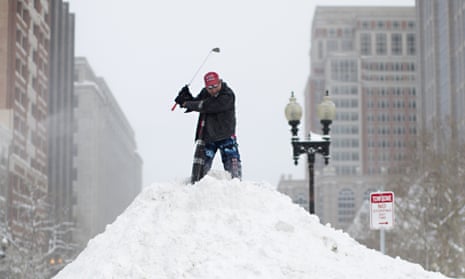Fears of an early rise in US interest rates dwindled on Wednesday after the Federal Reserve responded to news that growth had come to a virtual standstill by saying it would need to see a stronger economic performance before sanctioning an increase in borrowing costs.
Announcing its decision to leave interest rates on hold just hours after official data showed the world’s largest economy barely grew in the first three months of the year, the US central bank said only some of the weakness was due to one-off factors.
The Fed made it clear to Wall Street in a statement that it was in no hurry to act. The announcement left the financial markets convinced that it would be September at the earliest before the key US interest rate was raised from its current range of 0-0.25%.
Winter weather was in part to blame for the US’s sluggish performance in the first quarter of 2015, when the annualised growth rate slid to just 0.2%.
But the Fed stressed in its statement that the slowdown was only partly due to “transitory” factors.
In its health check on the economy since its last meeting in March, the Fed said: “The pace of job gains moderated, and the unemployment rate remained steady. A range of labour market indicators suggests that underutilisation of labour resources was little changed.
“Growth in household spending declined; households’ real incomes rose strongly, partly reflecting earlier declines in energy prices, and consumer sentiment remains high. Business fixed investment softened, the recovery in the housing sector remained slow, and exports declined.”
Interest rates have been pegged at barely more than zero in the US for almost six-and-a-half years, but the Fed’s open market committee said it would only “be appropriate to raise the target range for the federal funds rate when it has seen further improvement in the labour market and is reasonably confident that inflation will move back to its 2% objective over the medium term”.
Financial markets had been braced for a slowdown in activity after brutal winter weather but not of the scale reported by the Commerce Department in Washington.
After the economy grew at an annual pace of 2.2% in the final three months of 2014, economists had been forecasting a slowdown to 1% in the subsequent quarter – a period in which blizzards and a strike affecting west coast ports stifled activity.
The official data showed that the drop in crude prices had affected investment in the US oil and gas sector but that cheaper energy bills had yet to boost consumer spending. Growth in consumer spending slowed to an annual increase of 1.9% in the first quarter, down from 4.4% in late 2014 and the weakest for a year.
Construction output was badly hit by the poor weather, leading some analysts to predict that the US would bounce back quickly in the second and third quarters of 2015, as it did in 2014.
But recent data for retail sales, housebuilding and business investment has not been strong, suggesting the rebound will be less vigorous this time.
Earlier this year, Wall Street had been anticipating that the Fed would start raising interest rates in June, but concerns about the sluggishness of growth mean that the expected date for a move by the central bank has been pushed back to September.
“A stalling of US economic growth at the start of the year rules out any imminent hiking of interest rates by the Fed,” said Chris Williamson of financial data provider Markit.
Paul Ashworth, the chief US economist at Capital Economics, said: “Most Fed officials appear to share our view that this is a temporary slowdown, albeit a more severe deceleration than we previously anticipated. Accordingly, while it might delay the timing of the first rate hike, we still anticipate a lift-off later this year.”
Speculation that the Fed would delay a rate rise pushed the dollar lower against the euro, with knock-on effects on share prices in Europe.
The German Dax index closed 378 points lower at 11,432.72, a drop of more than 3.2% in the expectation that a stronger euro would make German exports dearer. The main share index in France was down by 2.6%.
The Fed has provided unprecedented amounts of stimulus to the US economy since it plunged into recession in 2008 – keeping interest rates unchanged at barely above zero and creating trillions of dollars of new electronic money through the process known as quantitative easing. Even so, the recovery has been the weakest in the country’s recent history.

Comments (…)
Sign in or create your Guardian account to join the discussion